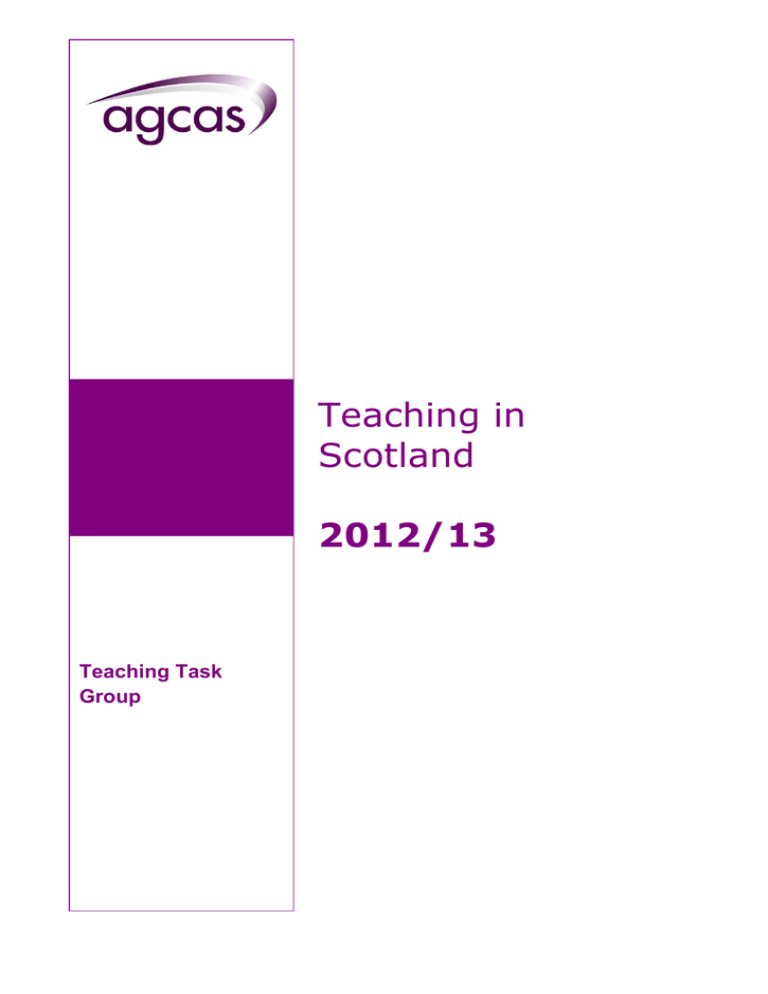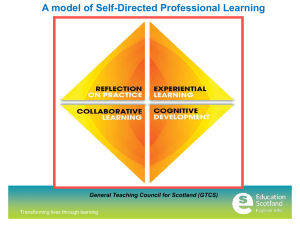Teaching in Scotland 2012/13
advertisement

Teaching in Scotland 2012/13 Teaching Task Group Teaching in Scotland Entry requirements All teachers in Scottish public sector schools must hold a teaching qualification (TQ) and be registered with the General Teaching Council for Scotland (GTCS). Although strictly not a requirement, the majority of teachers in the independent sector are registered with the GTCS. In some subjects, e.g. classics, GTCS registration is not necessarily required for applicants to independent schools if they can demonstrate appropriate experience. More information is available on the Scottish Council for Independent Schools website. Teachers who have trained in the rest of the UK are normally eligible for registration. Detailed information is provided on the GTCS website for teachers who have qualified outside the UK. To become fully registered with the GTCS you must: complete a course of initial teacher training (ITT); complete a probationary period, usually a year. You will also need to become a member of the Protecting Vulnerable Groups (PVG) Scheme. This is similar to the Criminal Records Bureau (CRB) checks in England and Wales. Further information is also available on the GTCS website. Teachers who qualify in Scotland should be able to apply for and obtain qualified teacher status (QTS) in England or Wales without further training or assessment. Contact the Teaching Agency for more information. Details can be found on the Department for Education website. Qualifications Qualifications required for entry to teacher training courses are determined by the Scottish government. See the Teach in Scotland website for details. The final decision on entry rests with the teacher education institution (TEI), and each TEI will have their own selection criteria. In brief, the entry requirements for primary courses are: three Highers (or equivalent) including English at grade C or above. Acceptable alternative qualifications include, among others, GCSE English language and literature at grade C or above; two Standard Grades (or equivalent) including mathematics at Credit level or Intermediate 2. Acceptable alternative qualifications include, among others, GCSE mathematics at Grade B or above; a degree from a UK university (or equivalent degree from outside the UK). You will also need to show evidence that you have studied at least two of the following subjects: science, social studies, expressive arts, religious and moral education, technology, and modern languages. For secondary courses you will need a Higher English qualification (or equivalent) as well as a degree from a UK university or an equivalent degree from outside the UK. Beyond this, there is some variation in entry requirements between TEIs and the subjects of study. However, your degree should normally contain a minimum of 80 Scottish Credit Qualifications Framework (SCQF) points in a subject relevant to the teaching qualification for which you are studying. 40 credit points must be at second-year undergraduate level (SCQF Level 8) or above. See the Teach in Scotland website for further details on required qualifications. You may also wish to contact subject or admissions tutors in the TEIs to which you are applying to discuss your individual circumstances. Work experience In addition to academic qualifications, you should demonstrate a genuine interest in working with and educating children of the age you wish to teach. You will need good experience of working with children, preferably in a Scottish school environment. Other relevant experience, such as Brownie or Cub leadership, after-school clubs, sports coaching, music tuition, student tutoring, sessional work in community education and youth organisations, mentoring schemes and working as a classroom assistant, will also be useful. See the AGCAS publication Routes into Teaching for further advice on gaining experience and current hot topics in education in the UK. Courses The main graduate route into teaching in Scotland is the full-time Professional Graduate Diploma in Education (PGDE) course, offered at six teacher education institutions (TEIs). In addition, there are some flexible and part-time options available. PGDEs are offered by the following Scottish universities: University University University University University University of of of of of of Aberdeen Dundee Edinburgh Glasgow Strathclyde the West of Scotland The Open University (OU) in Scotland also offers a flexible PGDE in secondary mathematics. Successful completion of a one-year PGDE course leads to a teaching qualification (TQ) in primary education or a TQ in secondary education and to provisional registration with the General Teaching Council for Scotland (GTCS). Applications for full-time primary and secondary PGDEs at Aberdeen, Dundee, Edinburgh, Glasgow and Strathclyde universities must be made through the Graduate Teacher Training Registry (GTTR). The closing date for primary PGDE courses is 1 December for courses starting in the following autumn. If the GTTR has not received your application by then they cannot guarantee that your first choice training provider will consider you. There is no application deadline for secondary PGDE courses but it is recommended that you apply as soon as possible after the GTTR applications system opens in September for courses starting the following autumn. The University of the West of Scotland accepts applications made directly and their closing date is in December. Teaching in further education (FE) Unlike England and Wales, there is no PGDE/PGCE further education (FE) qualification in Scotland. The TQ (FE) is the recognised teaching qualification for the FE sector in Scotland. Some people also choose to follow the secondary PGDE and then apply to teach their subject in the FE sector. The University of Aberdeen offers a programme for full- and part-time lecturers already working in FE. The University of Dundee provides an online distance learning route to TQ (FE) at both undergraduate and postgraduate level, for in-service lecturers only. The University of Stirling offers a flexible programme, leading to TQ (FE) for both pre-service candidates and in-service lecturers. Funding The government bursaries that operate in England do not apply to Scotland. Students studying full time for a PGDE can apply to the Student Awards Agency for Scotland (SAAS) for a loan and supplementary grants, which include travel expenses, lone parent grants, lone parent childcare grant and disabled students’ allowance. The exact amount awarded is dependent on household income. Most support funding is dependent on individual circumstances. Contact the SAAS to clarify your own situation. Some institutions may also have additional sources of funding - contact the relevant institution for information. Curriculum A revised curriculum known as the Curriculum for Excellence is being implemented in Scottish schools and began in the academic year 2010/11. The new curriculum will continue to be phased in until 2016, when the implementation will be completed. This will provide a single, coherent curriculum for all pupils aged 3-18 and aims to increase the emphasis on numeracy, literacy and pupil choice. Subject areas are: expressive arts, health and wellbeing, languages, mathematics, religious and moral education, sciences, social studies and technologies. Compulsory education begins in primary schools at the age of 5, and the move to secondary school takes place at age 12. Compulsory education ends at age 16, although most pupils stay in education until the age of 18. The school year begins in August rather than September. See the Education Scotland website for more information on the new curriculum. Additional information is also available from the Scottish Qualifications Authority (SQA). Applying for jobs To gain full registration with the General Teaching Council for Scotland (GTCS) you must complete a probationary period on finishing your initial teacher education (ITE). A successful probation year demonstrates that you have reached the Standard for Full Registration (SFR) and are a fully qualified teacher. Teaching Induction Scheme (TIS) Newly qualified teachers (NQTs) from Scottish TEIs who have been publicly funded (UK or EU fees) for their teacher training are eligible to join the Teacher Induction Scheme (TIS). This is a one-year training post with a local authority (LA) in Scotland. Successful completion of your probationary period via the TIS will lead to full registration with the GTCS, enabling you to apply for permanent teaching posts. The TIS operates in public sector schools and ensures that, as a probationary teacher: your maximum class commitment is 0.8 FTE (full-time equivalent); you will be allocated time for continuing professional development (CPD); you have access to a qualified, experienced teacher for support and as a mentor. Applications for the TIS are made centrally through the GTCS website. You can prioritise your five LA choices, after which, you will be allocated to an LA that will decide which school to place you in for your TIS year. Research the different authorities thoroughly and consider in which region you would like to work after completing your induction period. Or, you can waive your right to state your preferences under the Preference Waiver Payment scheme. By agreeing to work anywhere in Scotland for your induction year, you will receive an additional payment of £6,000 for primary and £8,000 for secondary. The current starting salary is £21,438. More detailed information about the TIS is available on the GTCS Probationer Teacher Scotland website. Flexible Route If you do not wish to join the TIS or are not eligible to do so, you can still complete your probation in the public sector via temporary contracts and supply teaching, but it is likely to take longer (270 teaching days as opposed to 190). Information about the Flexible Route is available from the GTCS Probationer Teacher Scotland website. Temporary posts are advertised in: Times Educational Supplement (Scotland) (TESS) The Scotsman The Herald regional newspapers. local authority (LA) websites. Contact individual LAs to find out how they operate supply teaching. A proactive approach to finding supply work is highly recommended. Let local schools know you are available for supply work. Although work is allocated through the LA, it can be helpful if schools know about you. You can find links to local government jobs listings at My Job Scotland. Teaching in the independent sector Probation teachers in independent schools have access to the same experience as those completing the TIS in the public sector, including the online probation profile system. Because the school year in independent schools is not exactly aligned with public sector schools, probationers in the independent sector complete the probation year through the Flexible Route. The Scottish Council of Independent Schools (SCIS) offers an extensive programme of CPD to probationers as well as experienced teachers. You will have to find opportunities as they are advertised, however, as independent schools are not part of the TIS database-matching scheme. Advertisements for independent sector probation positions can be found in the sources listed above. It is also worth making speculative applications by sending your CV directly to schools. Find out more about the independent sector and how to complete your probationary period on the SCIS website. The SCIS also maintains a supply list and advertises jobs. Teachers trained outside Scotland If you trained to teach outside Scotland you will need to register with the General Teaching Council for Scotland (GTCS) to teach in a public sector primary or secondary school. You will normally be eligible for exceptional admission to the teaching register, although you will be required to undertake a year’s probationary period. If you are already an experienced teacher, the main sources of vacancies are the same as for temporary posts. The GTCS website has extensive information for teachers who qualified outside Scotland as well as contact details for those wishing to discuss the application process. See the AGCAS publication Getting a Teaching Job for more detailed information on applying for jobs. Written by Darcey Gillie, University of Edinburgh, August 2012 © Content copyright of or licensed to AGCAS (www.agcas.org.uk). To view the terms and conditions for the material provided in this publication, please see: www.agcas.org.uk/disclaimer


